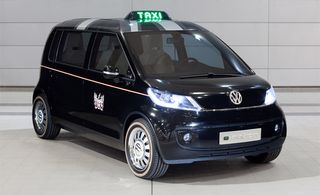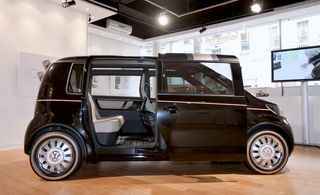Volkswagen Taxi Concept

Volkswagen's new conceptual electric taxi for London mixes cutting edge technology with deliberately tongue-in-cheek details such as the silver Union Jack on the roof and the City of London's coat of arms on the sides and dashboard. These embellishments conceal serious intent; the global market for taxis is burgeoning, but hampered by a host of ageing models long past retirement age.
'For me London has the most convincing taxi in the world,' confesses Klaus Bischoff, head of VW design and the force behind the project. 'The New York taxi is nice, but not as comfortable as the London cab. It gives the urban setting a unique character, and we wanted to pay tribute to this.'
The prototype is based on the forthcoming electric Up city car. It is relatively compact -- 3,730mm long, 1,680mm wide and 1,600mm high -- making it a little shorter than VW's smallest car, the Fox. However, the absence of a conventional engine at the front and clever packaging has allowed for a spacious interior that can sit a driver and two passengers in individual seats -- as opposed to the usual bench - comfortably, whilst leaving ample space for luggage secured inside the cabin area.
The taxi project is part of the carmaker's ongoing obsession with creating electric cars with character. With all-electric powered models still over a year away from production, it makes sense to prep a largely cynical market with ventures such as this. With the taxi, VW hopes to use the car's 'face' in order to make a unique impression. For this Bischoff and his team looked back at the marque's most iconic cars: the original Beetle and in particular the Campervan. 'People remember these vehicles positively,' explains Bischoff noting that it is this sense of nostalgia that needs to find its way into the entire electric car range.
'VWs were born with their engines in the rear and so there was an absence of a radiator grille on the face,' continues the designer. An electric car doesn't require an opening at the front -- there is no conventional engine to cool. Therefore like the Up, the taxi concept's face has a tiny ring shaped grille, there really to represents the mouth and in a sense complete the face. 'We wanted to give the car a unique look, but one that is friendly and sympathetic,' notes Bischoff.
Daytime running lights mounted within the headlight units are joined by a taxi light on the roof that offers a green setting when free and red one when not. At the rear the graphic light units are integrated into the split tailgate, behind which are a pair of cubbies to house the driver's belongings.
The interior is light and spacious, and visually dominated by two large touch screen displays -- one by the driver and one by the passengers -- that take directly both in terms of design and functionality from smart phones. 'We didn't want to create a normal dashboard because we have a completely different architecture with this car,' explains chief interior designer Tomasz Bachorski. The driver can personalise the display setting on the touch screen display and in the rear, a similar screen relays information to the passengers on their route and their immediate environment. Plus the reduced colour scheme that includes only a splash of red helps with electricity usage.
Wallpaper* Newsletter
Receive our daily digest of inspiration, escapism and design stories from around the world direct to your inbox.
Safety was also a key issue with the interior. 'It can be scary when you take a cab in a foreign country,' admits the interior designer. 'I remember the first time I went to New York, the Russian cab driver didn't speak a word of English and I was so scared.' Features like the translator help create a safer environment for the passenger.
Another safety feature is the payment system. The customer slides his credit card through the passenger display unit, enters the pin and when all is complete a signal is sent to the driver's display -- visible to the passenger - who checks all the details, prints or emails the receipt, and only when the transaction is complete, allows for the doors to open.
It takes just over an hour to charge the electric taxi's slim lithium-ion battery to 80per cent of its capacity. The 113bhp electric motor gives a top speed of 74mph, and the 45kWh battery provides a range of up to 186 miles.
The London taxi concept is the last in VW's World Taxis series that has thus far included a Hong Kong, Berlin and Milanese cab. The idea with these has been not only to provide a clean driving solution, but also a more modern and a safer taxi environment.
Will it be produced? Bischoff says that it could if it was done on a global scale. 'This car is made under a lot of technical restrictions and it is a feasible product,' he says, adding: 'If someone wanted, we could make it.' The Up is due in 2013 and given that the taxi is based on its underpinnings, it could indeed form part of London's urban landscape in the near future.

The prototype is based on the forthcoming electric Up city car.
It is relatively compact – 3,730mm long, 1,680mm wide and 1,600mm high – making it a little shorter than VW’s smallest car, the Fox. However, the absence of a conventional engine at the front and clever packaging has allowed for a spacious interior

For me London has the most convincing taxi in the world,’ confesses Klaus Bischoff, head of VW design and the force behind the project. ‘The New York taxi is nice, but not as comfortable as the London cab. It gives the urban setting a unique character, and we wanted to pay tribute to this.’

Daytime running lights mounted within the headlight units are joined by a taxi light on the roof that offers a green setting when free and red one when not. At the rear the graphic light units are integrated into the split tailgate, behind which are a pair of cubbies to house the driver’s belongings.

‘VWs were born with their engines in the rear and so there was an absence of a radiator grille on the face,’ continues the designer. An electric car doesn’t require an opening at the front – there is no conventional engine to cool. Therefore like the Up, the taxi concept’s face has a tiny ring shaped grille, there really to represents the mouth and in a sense complete the face. ‘We wanted to give the car a unique look, but one that is friendly and sympathetic,’ notes Bischoff.


It takes just over an hour to charge the electric taxi’s slim lithium-ion battery to 80per cent of its capacity. The 113bhp electric motor gives a top speed of 74mph, and the 45kWh battery provides a range of up to 186 miles.

The interior can sit a driver and two passengers in individual seats – as opposed to the usual bench - comfortably, whilst leaving ample space for luggage secured inside the cabin area.

The London taxi concept is the last in VW’s World Taxis series that has thus far included a Hong Kong, Berlin and Milanese cab. The idea with these has been not only to provide a clean driving solution, but also a more modern and a safer taxi environment.
A writer and editor based in London, Nargess contributes to various international publications on all aspects of culture. She is editorial director on Voices, a US publication on wine, and has authored a few lifestyle books, including The Life Negroni.
-
 Three new coffee makers for a contemporary brew, from a casual cup to a full-on branded espresso
Three new coffee makers for a contemporary brew, from a casual cup to a full-on branded espressoThree new coffee makers, from AeroPress, Jura and Porsche x La Marzocco, range from the defiantly manual to the bells and whistles of a traditional countertop espresso machine
By Jonathan Bell Published
-
 Don't miss Luxembourg's retro-futuristic lab pavilion in Venice
Don't miss Luxembourg's retro-futuristic lab pavilion in VeniceAs the Venice Biennale enters its last few weeks, catch 'A Comparative Dialogue Act' at the Luxembourg Pavilion
By Amah-Rose Abrams Published
-
 A Berlin park atop an office building offers a new model of urban landscaping
A Berlin park atop an office building offers a new model of urban landscapingA Berlin park and office space by Grüntuch Ernst Architeken offer a symbiotic relationship between urban design and green living materials
By Michael Webb Published
-
 Volkswagen celebrates 50 years of the Golf, its most famous modern model, with a flight of fancy
Volkswagen celebrates 50 years of the Golf, its most famous modern model, with a flight of fancyWallpaper* travelled to eastern Turkey in search of the perfect backdrop to mark 50 years and eight generations of the evergreen VW Golf
By Adam Hay-Nicholls Published
-
 We sample the world’s first all-electric DeLorean, a stainless steel marvel for the modern age
We sample the world’s first all-electric DeLorean, a stainless steel marvel for the modern ageElectrogenic brings its brilliance with batteries and motors to bear on the iconic DeLorean DMC-12, giving this classic design the futuristic feel it deserves
By Jonathan Bell Published
-
 Bentley rolls out the latest version of its majestic grand tourer, the Continental GT Speed
Bentley rolls out the latest version of its majestic grand tourer, the Continental GT SpeedAvailable as both coupé and convertible, the fourth generation Bentley Continental GT Speed harnesses hybrid power to become a record breaker for the brand
By Jonathan Bell Published
-
 Fiat Grande Panda first look: will retro-seeking lightning strike twice?
Fiat Grande Panda first look: will retro-seeking lightning strike twice?This is the new Fiat Grande Panda, a compact hybrid and electric car that brings delightful design back to a well-loved model
By Jonathan Bell Published
-
 New Volkswagen California is a hybridised camper van that has it all
New Volkswagen California is a hybridised camper van that has it allThe Volkswagen New California camper van is here, the latest update to VW’s evergreen classic, bringing a larger platform, more flexibility and hybrid power for the first time
By Jonathan Bell Published
-
 New Rivian R2 and R3 downsize a format to increase the EV company’s standings
New Rivian R2 and R3 downsize a format to increase the EV company’s standingsThe Californian manufacturer has revealed the new Rivian R2 and R3, all-electric SUVs that combine practicality with functional elegance
By Jonathan Bell Published
-
 VW Golf at 50: the new model, and a look back at the pioneering small car
VW Golf at 50: the new model, and a look back at the pioneering small carA VW Golf update brings new tech, innovations and efficiencies to keep the car at the heart of the brand 50 years after its debut
By Jonathan Bell Published
-
 CES 2024 was a showcase for how to shoehorn AI into next-generation cars
CES 2024 was a showcase for how to shoehorn AI into next-generation carsCES 2024 in Las Vegas underlined that future mobility will be shaped by AI, like it or not, as intelligent assistants emerge to guide, plan and converse with their human cargo
By Jonathan Bell Published